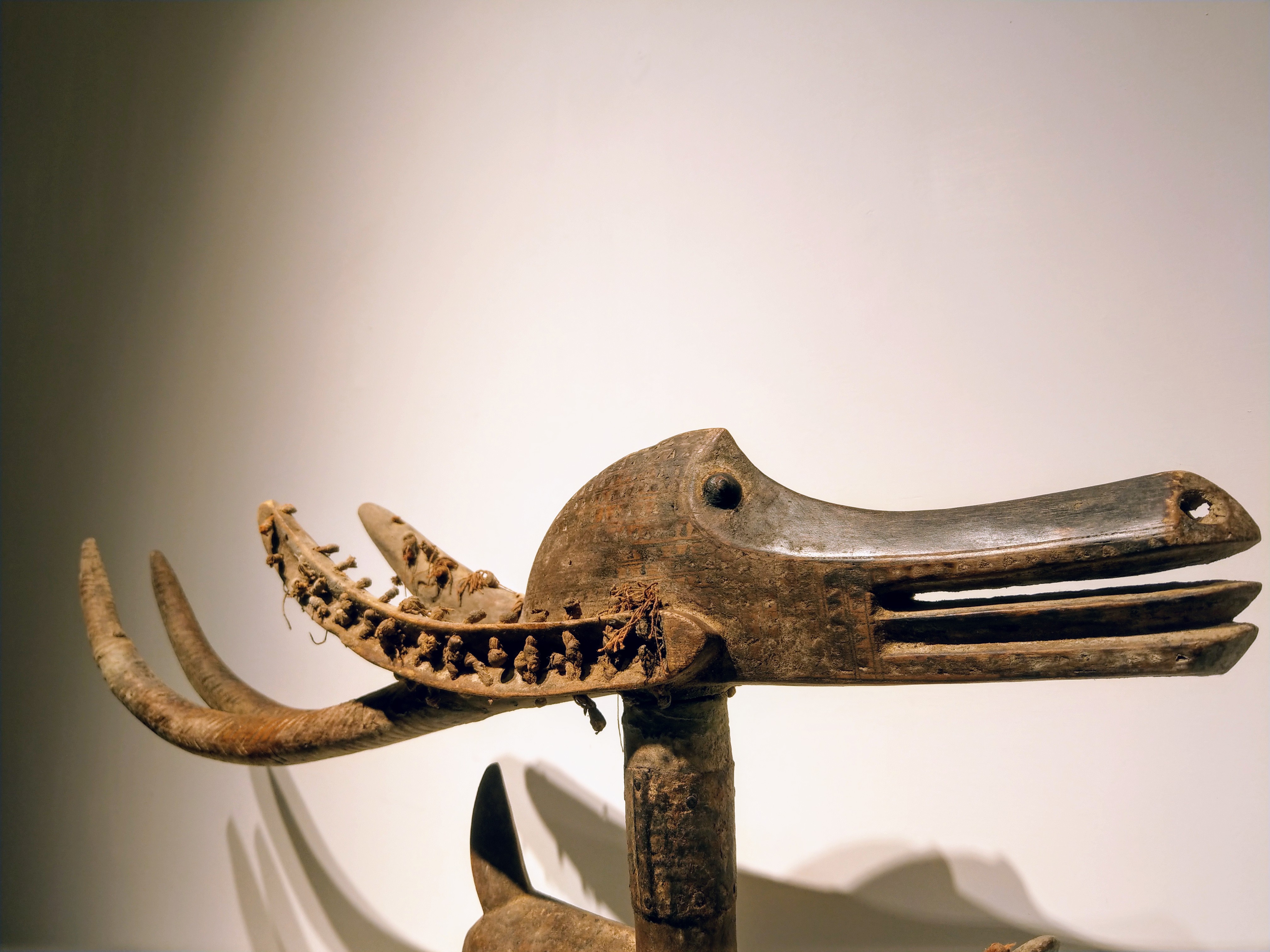The Story of Myth
"The soul of African tribal art and culture is seamlessly fused with contemporary design in these works. Like a spark of art in the space, they inject the aesthetic power of tribal creativity into everyday life, offering a completely different sense of living and enjoyment.
Fashion and art intertwine here, allowing us to reexamine the beauty of African tribes from a modern perspective, experiencing the resonance between the ancient and the contemporary. Each piece not only tells a story of history but also awakens our pursuit of aesthetics, letting us feel the eternal breath of art in our daily lives."
- 44 GALLERY. 小巴廊

Noble bronze leopard head
Nigeria Benin
W15 H26 D18
Copper. pigment
19th-20th Century
USD. 80,000.
The bronze leopard head represents success in all aspects and is said to bring protection and a positive spirit of hard work to the king, helping to protect the country from hostile forces because the leopard is a symbol of strength and the metal also represents steadfastness.
The leopard is also one of the most commonly depicted animals in African tribal art.
They are intelligent and courageous, and are often metaphors for powerful individuals or associations.
In Benin, the leopard is considered the king of the forest and is therefore seen as a symbol of authority. The leopard is the royal symbol of kingship as it embodies the totality of courage, strength, ferocity and wisdom.


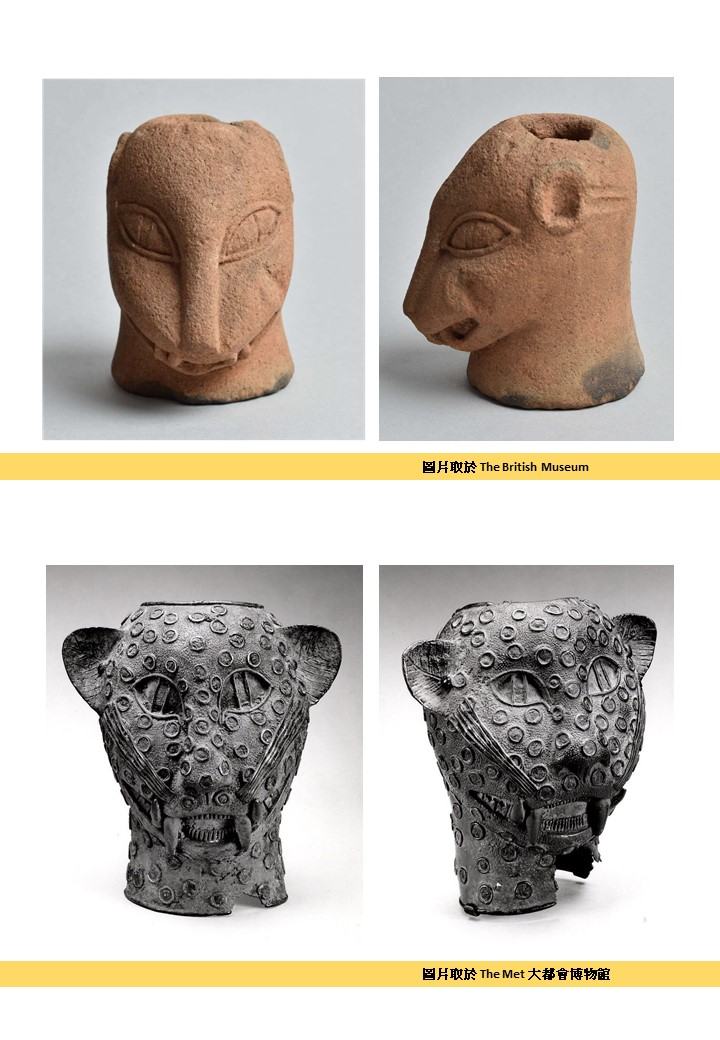

Magic Man Statue / Congo
H50 W22 D14
Wood. pigment. metal. Mirror. plant fiber
USD. 36,000.
The Magic Man statue combines an expression of beauty and strength with the absolute authority of the Congolese nobility,
The most special part is that the hands are simplified and the abdomen is enlarged in an elliptical shape to add magical features. What is also interesting is that the glass on the abdomen is cleverly similar to the shape of Taiwan, which adds an extra sense of surprise to the work. The material metaphor of the glass on the abdomen is Prophecies of the future can be seen through the glass.
The magic man symbolizes the judge between tribes and is a representative of justice. Each metal object behind it represents a powerful benevolent force that can help people solve problems. People hammer nails or other iron tools into the statue to make it powerful. , and expressed respect for its supernatural power. Ironware is an extremely precious item in Congo. Congolese people believe that ironware has special meaning. Therefore, Congolese people often use ironware to increase their strength when praying, making contracts, swearing oaths, and making wishes.
In addition, mirror or glass also plays an important role in Congolese statues, as Congolese believe that it can put the energy of nature into the statue.
The most fascinating thing about the statue is that it uses different objects to create a strong visual impact. It is also the strongest representative of Congolese art.
![]()
![]()
![]()
H50 W22 D14
Wood. pigment. metal. Mirror. plant fiber
USD. 36,000.
The Magic Man statue combines an expression of beauty and strength with the absolute authority of the Congolese nobility,
The most special part is that the hands are simplified and the abdomen is enlarged in an elliptical shape to add magical features. What is also interesting is that the glass on the abdomen is cleverly similar to the shape of Taiwan, which adds an extra sense of surprise to the work. The material metaphor of the glass on the abdomen is Prophecies of the future can be seen through the glass.
The magic man symbolizes the judge between tribes and is a representative of justice. Each metal object behind it represents a powerful benevolent force that can help people solve problems. People hammer nails or other iron tools into the statue to make it powerful. , and expressed respect for its supernatural power. Ironware is an extremely precious item in Congo. Congolese people believe that ironware has special meaning. Therefore, Congolese people often use ironware to increase their strength when praying, making contracts, swearing oaths, and making wishes.
In addition, mirror or glass also plays an important role in Congolese statues, as Congolese believe that it can put the energy of nature into the statue.
The most fascinating thing about the statue is that it uses different objects to create a strong visual impact. It is also the strongest representative of Congolese art.


MUMUYE Guardian Head and Chest Statue / Nigeria
H42 W19 D22
Wood. pigment. metal
Due to the passage of time, this Mumiya shoulder mask retains the head features that transcend the overall sculpture, which presents a brand new visual impact.
The sculpted details of the face are built on the tension between the totems of lines that join together to form ridges and geometry. The nose and mouth are carefully represented and enhanced with red and white paint, while the large, round The eyes enliven the whole. The eyes contrast with the large rectangular ears on both sides. In addition, the biggest highlight is the metal piece that extends from the top of the head to the side of the neck. It has a beautiful patina over time, which proves its great ritual value and makes the beauty of the work even more charming.
![]()
![]()
![]()
![]()
![]()
H42 W19 D22
Wood. pigment. metal
Due to the passage of time, this Mumiya shoulder mask retains the head features that transcend the overall sculpture, which presents a brand new visual impact.
The sculpted details of the face are built on the tension between the totems of lines that join together to form ridges and geometry. The nose and mouth are carefully represented and enhanced with red and white paint, while the large, round The eyes enliven the whole. The eyes contrast with the large rectangular ears on both sides. In addition, the biggest highlight is the metal piece that extends from the top of the head to the side of the neck. It has a beautiful patina over time, which proves its great ritual value and makes the beauty of the work even more charming.




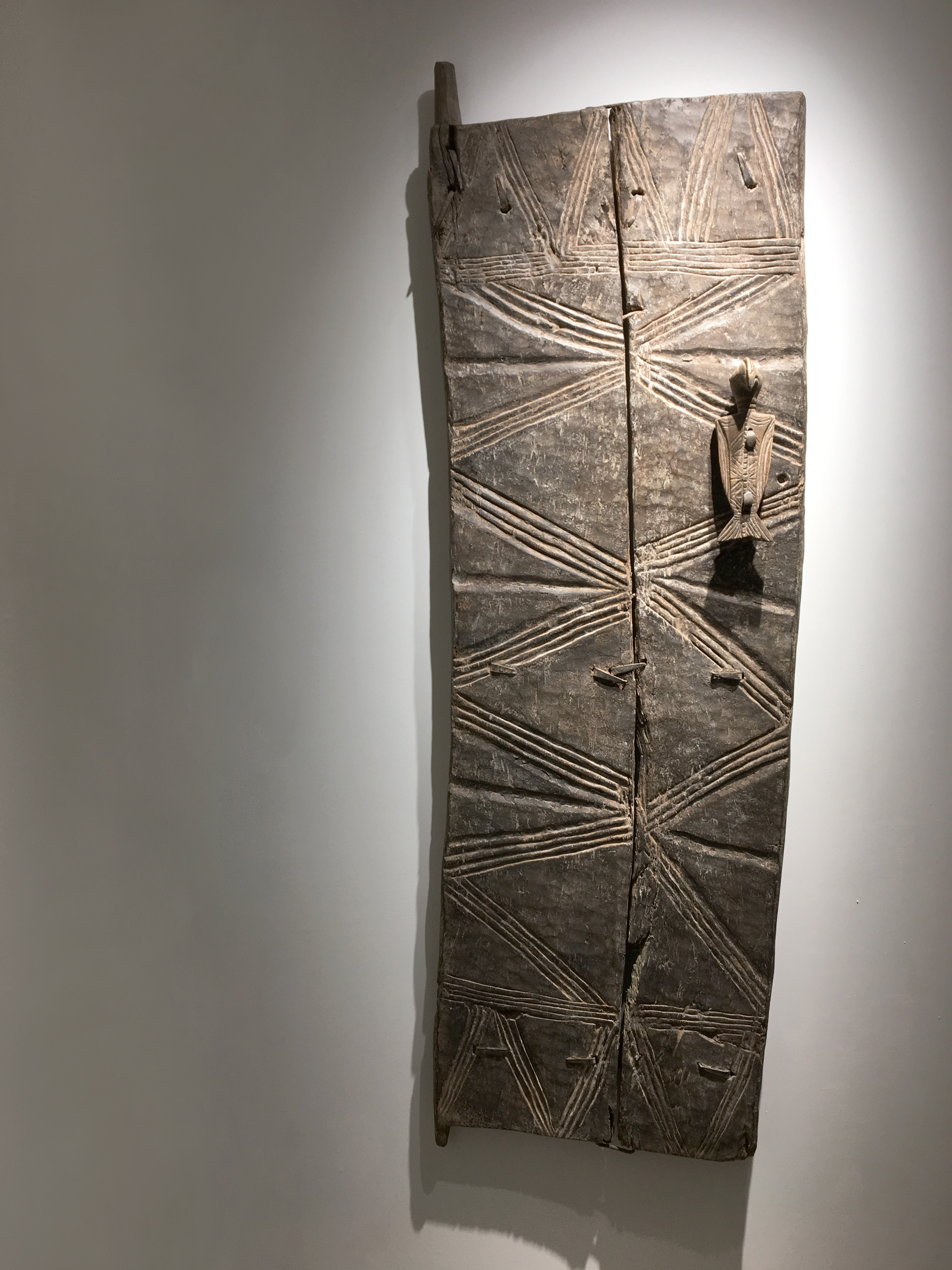
Prophetic bird door panel / Mali
H166 W54 D10
Wood. pigment. metal
USD. 36,000.
This outstanding door panel combines abstract line symbols with a prophetic bird-like bird and fish-like shape guarding -
The granary door is located on a family's granary.
The higher the status, the more elaborate and complex the design of the granary door.
These gates were created to protect the Dogon people's harvests.
Images of people or animals are carved on the doors, and the animals are considered to have special spirits or symbols.
The purpose is to protect what's inside the door.
Located in an area with very low vegetation, the Dogon value the food they have and need to protect it.
Additionally, these gates impart a spiritual presence to fertility and agriculture. In Dogon society, birds are symbols of fertility.
![]()
![]()
![]()
![]()
H166 W54 D10
Wood. pigment. metal
USD. 36,000.
This outstanding door panel combines abstract line symbols with a prophetic bird-like bird and fish-like shape guarding -
The granary door is located on a family's granary.
The higher the status, the more elaborate and complex the design of the granary door.
These gates were created to protect the Dogon people's harvests.
Images of people or animals are carved on the doors, and the animals are considered to have special spirits or symbols.
The purpose is to protect what's inside the door.
Located in an area with very low vegetation, the Dogon value the food they have and need to protect it.
Additionally, these gates impart a spiritual presence to fertility and agriculture. In Dogon society, birds are symbols of fertility.


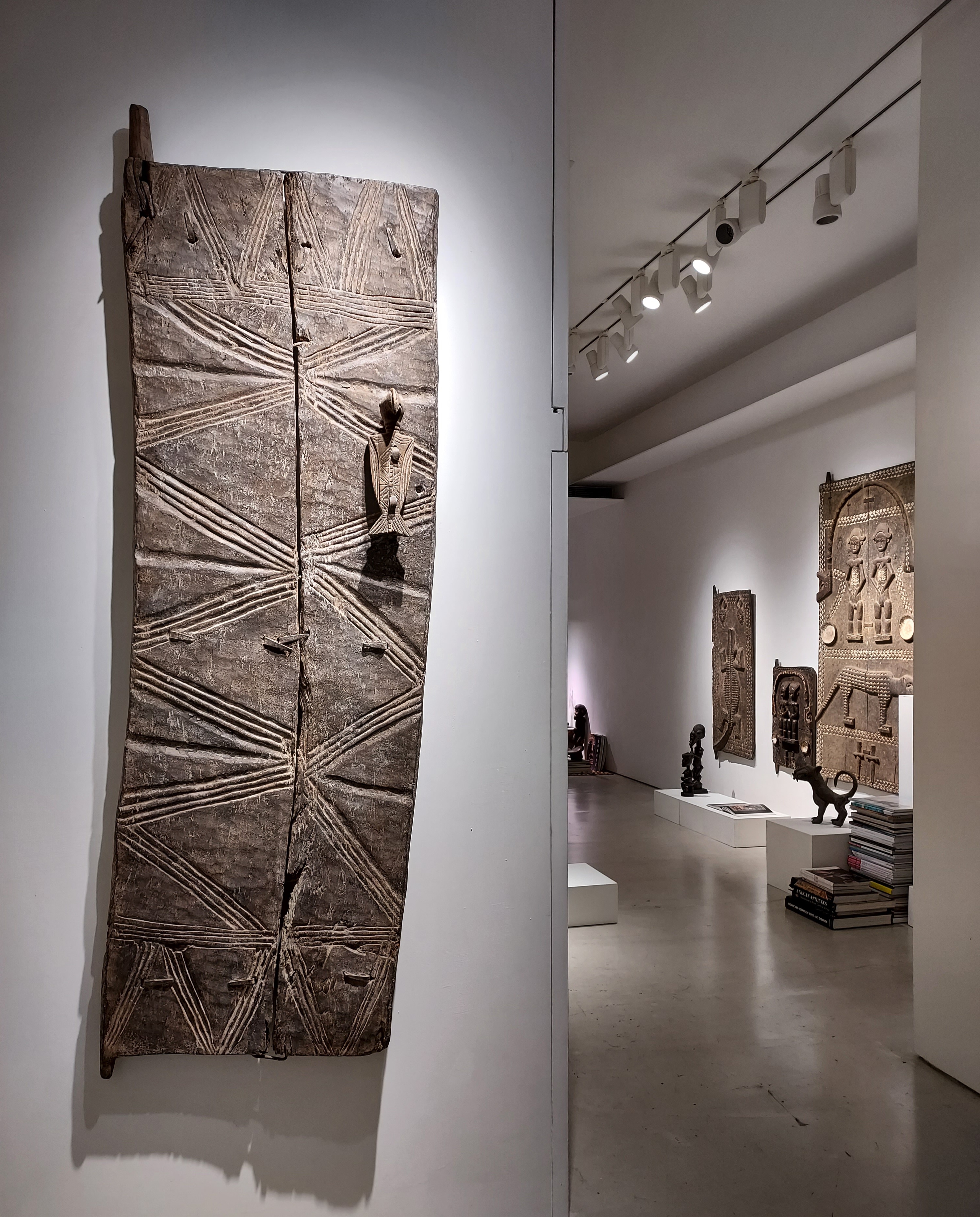

Hei-Tiki guardian accessories
New Zealand. Maori
H12 W6 D0.5
Animal bones. pigment
Post 70s
USD. 18,000.
This Hei-Tiki accessory is a carved figure that hangs around the neck.
Understood as a fertility symbol, a representation of the human embryo and a spiritual image. Among Māori, they are exchanged as gifts and inherited by future generations, giving them status as heirlooms.
![]()
![]()
![]()
New Zealand. Maori
H12 W6 D0.5
Animal bones. pigment
Post 70s
USD. 18,000.
This Hei-Tiki accessory is a carved figure that hangs around the neck.
Understood as a fertility symbol, a representation of the human embryo and a spiritual image. Among Māori, they are exchanged as gifts and inherited by future generations, giving them status as heirlooms.

MOBA Guardian Statue / Togo
H115 W23 D30
Wood. pigment
One of Africa's most minimalist sculptures, the statue is carved from hardwood that has weathered over time and depicts a standing figure with arms separated along the body. Its distinguishing feature is its head, a round head without eyes, nose or ears, giving it an expression that is both powerful and mysterious.
The pose of the figure contrasts with the calm expressiveness of its face, creating a delicate balance between the undulating movement of the wood stripes and the face. This tension between stillness and vivid expression gives the work a captivating presence. Deep internal erosion testifies to the age and history of the statue, adding a temporal dimension to its aesthetics, making this a masterpiece.
This piece embodies Moba’s creativity while reflecting the values and beliefs embedded in this culture.
![]()
![]()
![]()
![]()
H115 W23 D30
Wood. pigment
One of Africa's most minimalist sculptures, the statue is carved from hardwood that has weathered over time and depicts a standing figure with arms separated along the body. Its distinguishing feature is its head, a round head without eyes, nose or ears, giving it an expression that is both powerful and mysterious.
The pose of the figure contrasts with the calm expressiveness of its face, creating a delicate balance between the undulating movement of the wood stripes and the face. This tension between stillness and vivid expression gives the work a captivating presence. Deep internal erosion testifies to the age and history of the statue, adding a temporal dimension to its aesthetics, making this a masterpiece.
This piece embodies Moba’s creativity while reflecting the values and beliefs embedded in this culture.



Female statue chair and stool / Congo
Wood. pigment. plant fiber
USD. 36,000.
In many cultures in the southeastern region of the Democratic Republic of the Congo (and indeed in most of Africa), the leader's seat is an important symbol of power and authority. Rank and title were expressed through gradual progression to more prestigious seating forms, starting with simple woven cushions, to animal skins, clay thrones, and finally carved wooden thrones, as kings and chiefs inherited power and gained As a proper symbol of office, the stool occupied an important place in the strict royal investiture ceremony. The main function of the stool is not as a seat, but as a container of the chief's spirit and a powerful symbol of the chief's power and identity.
![]()
![]()
![]()
Wood. pigment. plant fiber
USD. 36,000.
In many cultures in the southeastern region of the Democratic Republic of the Congo (and indeed in most of Africa), the leader's seat is an important symbol of power and authority. Rank and title were expressed through gradual progression to more prestigious seating forms, starting with simple woven cushions, to animal skins, clay thrones, and finally carved wooden thrones, as kings and chiefs inherited power and gained As a proper symbol of office, the stool occupied an important place in the strict royal investiture ceremony. The main function of the stool is not as a seat, but as a container of the chief's spirit and a powerful symbol of the chief's power and identity.
Mask / Congo
H27 W18 D10
Wood. pigment
Mask of the KELA ethnic group in the Congo region of Africa. The work can be identified by the red and white pigments and kaolin clay. The lively multi-color stripes add visual interest to reflect its vibrant personality and show a strong appeal. Its uniqueness leaves an impression on people. A deep impression.
The KELA people live in the Democratic Republic of Congo, they are a small tribe of the Mbole who have the same branch as the Lilwa secret society and whose works are closely related.
![]()
![]()
H27 W18 D10
Wood. pigment
Mask of the KELA ethnic group in the Congo region of Africa. The work can be identified by the red and white pigments and kaolin clay. The lively multi-color stripes add visual interest to reflect its vibrant personality and show a strong appeal. Its uniqueness leaves an impression on people. A deep impression.
The KELA people live in the Democratic Republic of Congo, they are a small tribe of the Mbole who have the same branch as the Lilwa secret society and whose works are closely related.

Monkey man statue holding container / Ivory Coast
H57 W17 D18
Wood. pigment
USD. 22,000.
The most distinctive feature of the work is that the hands holding the bowl symbolize harmony and strength. The heels of the feet are slightly raised to create a dynamic visual sense of balance. In addition, standing with the feet slightly bent is also one of the characteristics of the Bowler statues. The monkey's The facial features are elongated and transformed in proportion, producing interesting and geometric effects. The deep eye sockets and the facial features form a strong sense of emotion. The zigzag shape of the back and the expression of the huge soles of the feet further strengthen the body's sense of strength and stability. In addition, the surface that has been peeled off by the years and the elegant posture convey a quiet protectiveness.
The Baule people are one of the largest ethnic groups in Ivory Coast, and monkey-man statues form an important part of their art.
In the culture of the Baule tribe, monkey people have the spirit of protecting the health and fertility of the family.
Therefore, they usually hide in the jungle to protect their homes and villages. Or pray for a bountiful harvest and successful hunting during farming celebrations.
![]()
![]()
![]()
![]()
H57 W17 D18
Wood. pigment
USD. 22,000.
The most distinctive feature of the work is that the hands holding the bowl symbolize harmony and strength. The heels of the feet are slightly raised to create a dynamic visual sense of balance. In addition, standing with the feet slightly bent is also one of the characteristics of the Bowler statues. The monkey's The facial features are elongated and transformed in proportion, producing interesting and geometric effects. The deep eye sockets and the facial features form a strong sense of emotion. The zigzag shape of the back and the expression of the huge soles of the feet further strengthen the body's sense of strength and stability. In addition, the surface that has been peeled off by the years and the elegant posture convey a quiet protectiveness.
The Baule people are one of the largest ethnic groups in Ivory Coast, and monkey-man statues form an important part of their art.
In the culture of the Baule tribe, monkey people have the spirit of protecting the health and fertility of the family.
Therefore, they usually hide in the jungle to protect their homes and villages. Or pray for a bountiful harvest and successful hunting during farming celebrations.




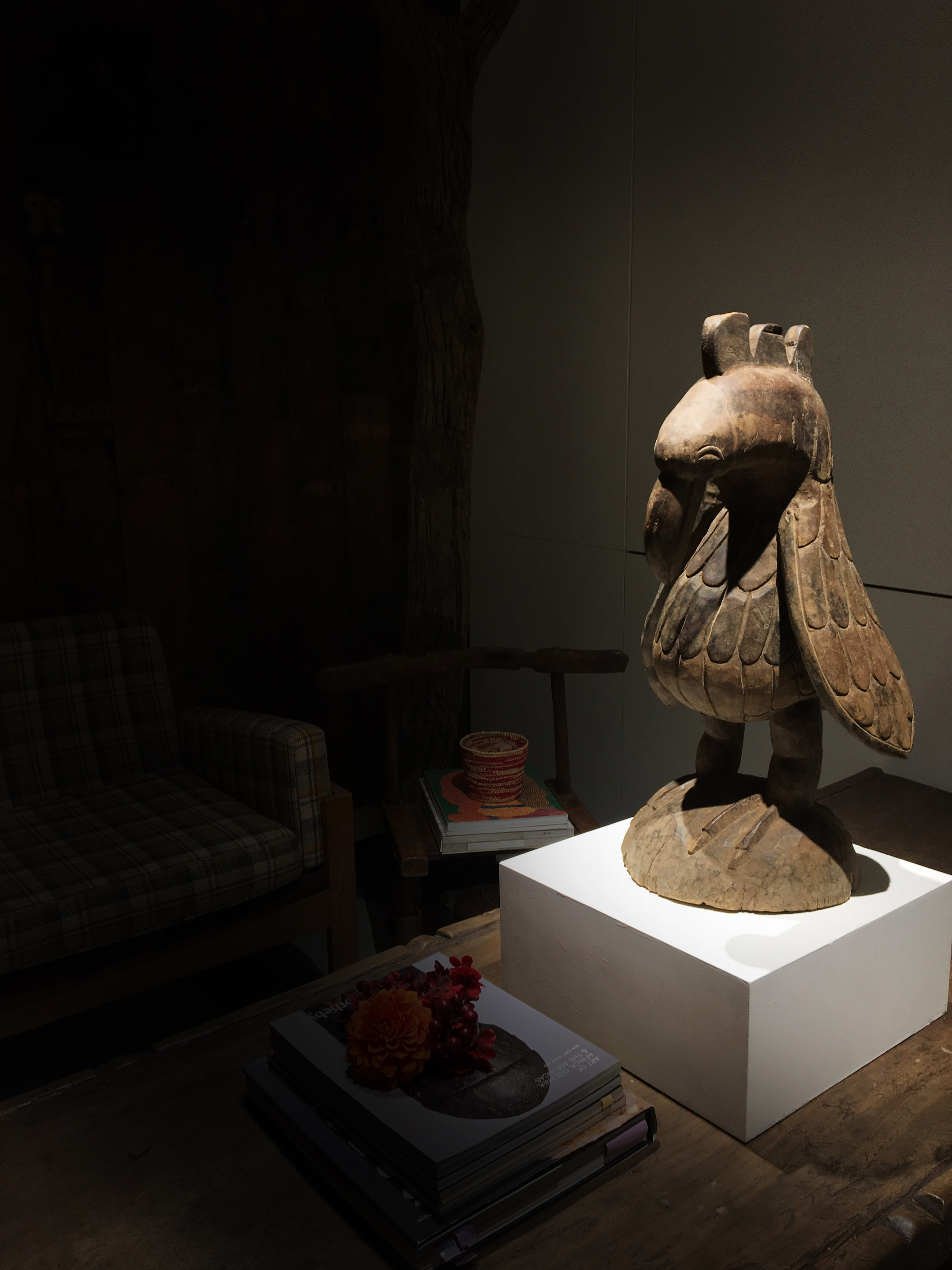
Prophetic bird statue / Burkina Faso
H60 W31 D32
Wood. Pigment
USD. 24,000.
This prophetic bird statue collected in Burkina Faso has a rare and round standing posture of 60 centimeters in height and a very warm and joyful presence. The round body is even more vivid when decorated with feathers. If you look carefully, each feather line shows a rigorous spirit. In addition, the red mineral pigment on the bird's beak is a charming trace of time. The simple and honest posture is like a penguin, especially the round belly and thick wings, which are peaceful. The overall appearance of the guardian is very happy, and the warm and down-to-earth atmosphere is spreading infinitely.
![]()
![]()
H60 W31 D32
Wood. Pigment
USD. 24,000.
This prophetic bird statue collected in Burkina Faso has a rare and round standing posture of 60 centimeters in height and a very warm and joyful presence. The round body is even more vivid when decorated with feathers. If you look carefully, each feather line shows a rigorous spirit. In addition, the red mineral pigment on the bird's beak is a charming trace of time. The simple and honest posture is like a penguin, especially the round belly and thick wings, which are peaceful. The overall appearance of the guardian is very happy, and the warm and down-to-earth atmosphere is spreading infinitely.


Male magic statue / Congo
W:12.H:57.D:25.
Wood. Pigment. Plant fiber
Shells. Animal bones. Metal
USD. 40,000.
Among all the traditional arts of central Africa, Songye sculptures represent a form of beauty that is extremely elegant and powerfully complex.
"Classic" features of Songye statues include: a generally cylindrical shape; an elaborate hairstyle, a sign of a senior leader, headdress representation often bounded by the hairline, sometimes with one or more horns on top of the head; face The body proportions are usually in the shape of an inverted triangle, with a directly confrontational expression, protruding large eyes and a mouth that sometimes exposes teeth; a cylindrical neck is connected to the body's belly, and the part located in the abdomen will be filled with magic materials ; Place the arms symmetrically, bending the elbows, and placing the hands on either side of the abdomen; Above the large paddle-shaped soles are short, powerful legs, usually standing on an overall carved cylindrical base, the overall shape is a very creative visual vocabulary .
The image of the Songye statue aims to serve the entire society and the entire village, using the statue to defend life and fight against diseases, improve fertility, and even provide specific pursuits of success and wealth. The statues are endowed with magical equipment and contain substances that symbolize spiritual power and are composed of animals, plants and minerals. Incorporating external accessories into the statue itself, some materials are easily identifiable and have a direct association with powerful properties in nature: the feathers of a bird of prey, the skin of a venomous snake, the horns of a large mammal, or the teeth or claws of a predatory animal. There is also intangible symbolism, such as the addition of metal nails from trees that have been struck by lightning to the faces of Songye characters, because the blacksmith represents a symbol of manipulation of nature, the danger of lightning, and the power given by nature. Through the power of the statue, you can directly and forcefully fight against the enemy and achieve a desired result.
From the unique and powerful visual shape of Songye statues and their worship of magicians, there is unlimited imagination. Today, they are regarded as one of the highest achievements of African traditional art.
![]()
![]()
![]()
W:12.H:57.D:25.
Wood. Pigment. Plant fiber
Shells. Animal bones. Metal
USD. 40,000.
Among all the traditional arts of central Africa, Songye sculptures represent a form of beauty that is extremely elegant and powerfully complex.
"Classic" features of Songye statues include: a generally cylindrical shape; an elaborate hairstyle, a sign of a senior leader, headdress representation often bounded by the hairline, sometimes with one or more horns on top of the head; face The body proportions are usually in the shape of an inverted triangle, with a directly confrontational expression, protruding large eyes and a mouth that sometimes exposes teeth; a cylindrical neck is connected to the body's belly, and the part located in the abdomen will be filled with magic materials ; Place the arms symmetrically, bending the elbows, and placing the hands on either side of the abdomen; Above the large paddle-shaped soles are short, powerful legs, usually standing on an overall carved cylindrical base, the overall shape is a very creative visual vocabulary .
The image of the Songye statue aims to serve the entire society and the entire village, using the statue to defend life and fight against diseases, improve fertility, and even provide specific pursuits of success and wealth. The statues are endowed with magical equipment and contain substances that symbolize spiritual power and are composed of animals, plants and minerals. Incorporating external accessories into the statue itself, some materials are easily identifiable and have a direct association with powerful properties in nature: the feathers of a bird of prey, the skin of a venomous snake, the horns of a large mammal, or the teeth or claws of a predatory animal. There is also intangible symbolism, such as the addition of metal nails from trees that have been struck by lightning to the faces of Songye characters, because the blacksmith represents a symbol of manipulation of nature, the danger of lightning, and the power given by nature. Through the power of the statue, you can directly and forcefully fight against the enemy and achieve a desired result.
From the unique and powerful visual shape of Songye statues and their worship of magicians, there is unlimited imagination. Today, they are regarded as one of the highest achievements of African traditional art.

Male mask / Gabon
H20 W28 D20
Wood. Pigment. Plant fiber
USD. 18,000.
![]()
![]()
![]()
H20 W28 D20
Wood. Pigment. Plant fiber
USD. 18,000.
Virgin Mary statue / Congo
H48 W9 D7
Wood. Pigment.
USD. 10,000.
This Congolese statue of the Virgin Mary and the Child has rare perfect proportions. The height of the work is divided into three sections: head, neck to navel, and navel to feet. These three sections are based on the head and divided into an integer ratio of approximately 1:3:5, which has become the most standard rule for human body beauty.
The pleats of the robe on the work drape naturally, and the lines are smooth and graceful. The gentle gesture of holding the child and the firm expression exude the beauty of motherhood, and the faces of the Virgin and the Son are also presented in an African style.
Madonna is a medieval Italian term for a noble or otherwise important woman, and has long been used in reference to images of the Virgin Mary.
![]()
![]()
H48 W9 D7
Wood. Pigment.
USD. 10,000.
This Congolese statue of the Virgin Mary and the Child has rare perfect proportions. The height of the work is divided into three sections: head, neck to navel, and navel to feet. These three sections are based on the head and divided into an integer ratio of approximately 1:3:5, which has become the most standard rule for human body beauty.
The pleats of the robe on the work drape naturally, and the lines are smooth and graceful. The gentle gesture of holding the child and the firm expression exude the beauty of motherhood, and the faces of the Virgin and the Son are also presented in an African style.
Madonna is a medieval Italian term for a noble or otherwise important woman, and has long been used in reference to images of the Virgin Mary.
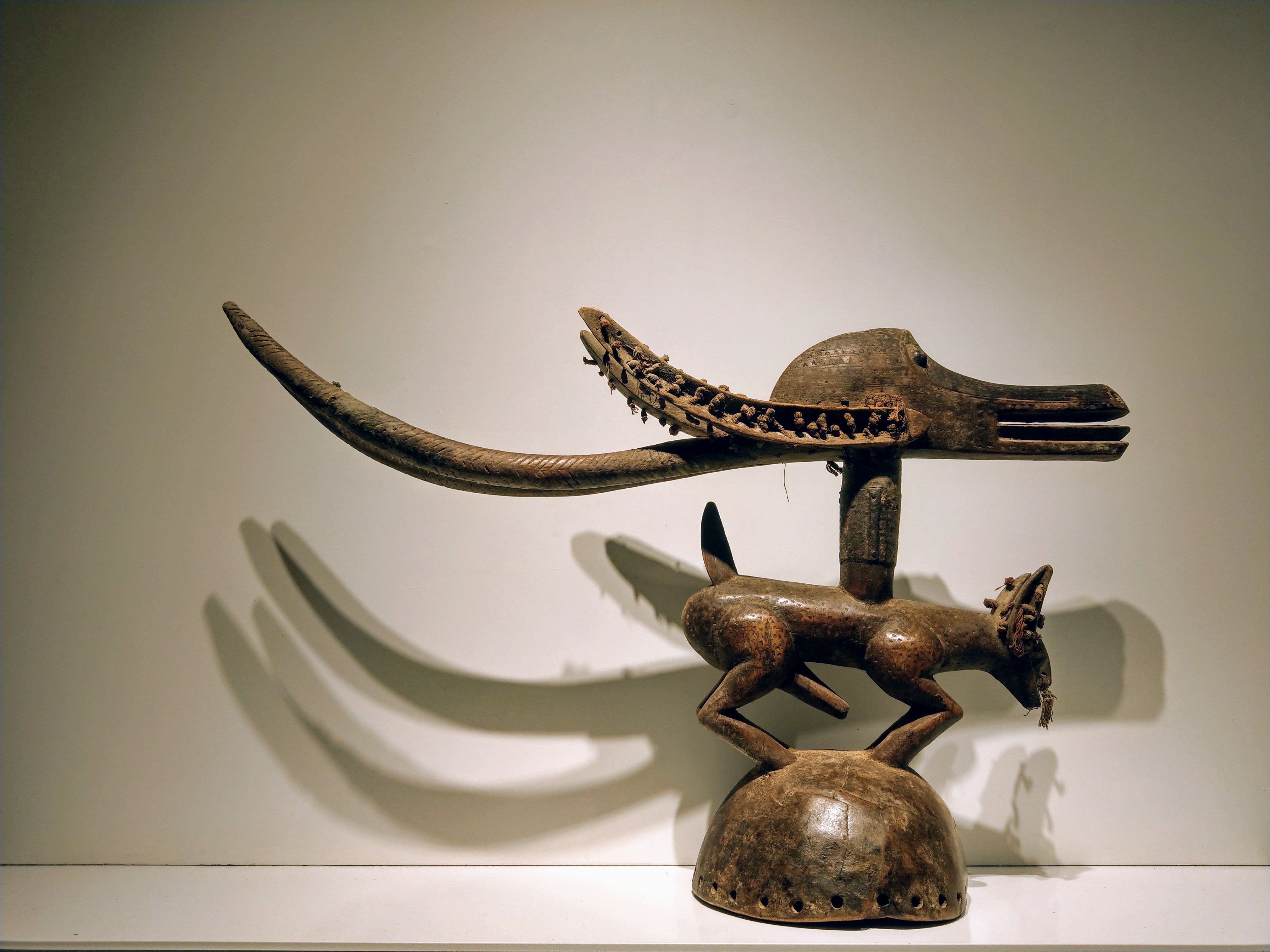
Headdress: Chi Wara / Mali
H42 W68 D19
Wood. Pigment . Metal. Animalskin. Fiber.
USD. 9,000.
The Bamana tribe of Mali, in their world, believe that they originated from antelopes....
Legend has it that in ancient times, Chi wara, half human and half antelope, gave humans the first grains and taught them how to farm and about seasons, soil and plant growth. This celebratory dance is held at the beginning and end of the farming cycle to pray for a good harvest.
You can feel the warmth of cultural connotation behind the tribal works, and the interpretation of symbolic images, from realistic and concrete to semi-concrete and abstract expressions, are skillfully transformed and applied in various forms. What is admirable is that they use natural resources Combined with their own imagination, they create works with unique original power and intuitive expression of shapes, always full of infinite possibilities.
![]()
![]()
![]()
![]()
H42 W68 D19
Wood. Pigment . Metal. Animalskin. Fiber.
USD. 9,000.
The Bamana tribe of Mali, in their world, believe that they originated from antelopes....
Legend has it that in ancient times, Chi wara, half human and half antelope, gave humans the first grains and taught them how to farm and about seasons, soil and plant growth. This celebratory dance is held at the beginning and end of the farming cycle to pray for a good harvest.
You can feel the warmth of cultural connotation behind the tribal works, and the interpretation of symbolic images, from realistic and concrete to semi-concrete and abstract expressions, are skillfully transformed and applied in various forms. What is admirable is that they use natural resources Combined with their own imagination, they create works with unique original power and intuitive expression of shapes, always full of infinite possibilities.



